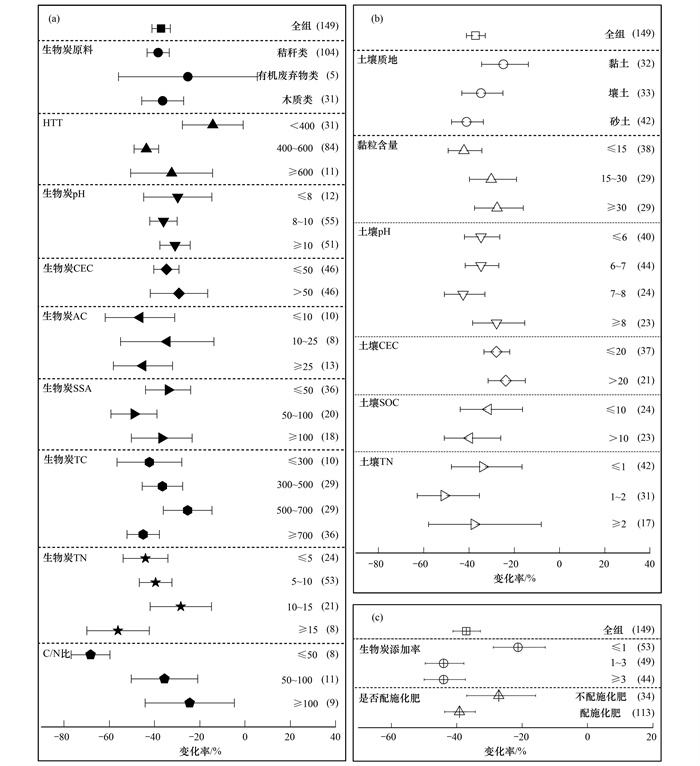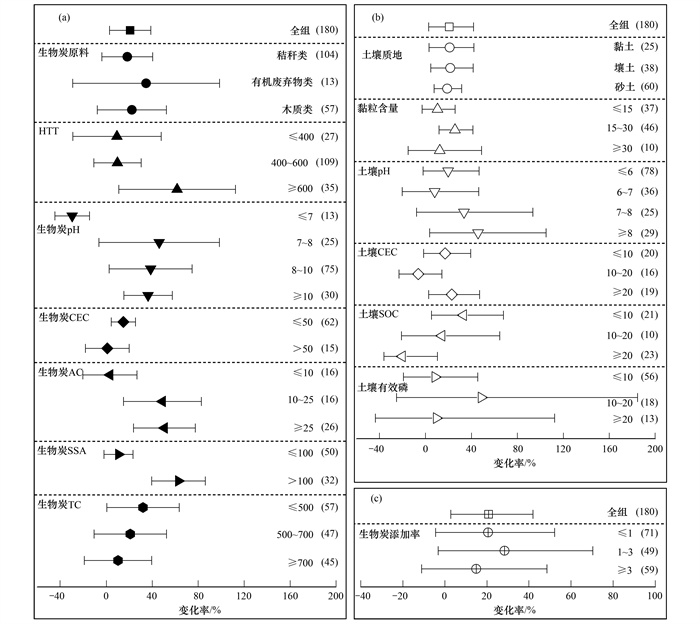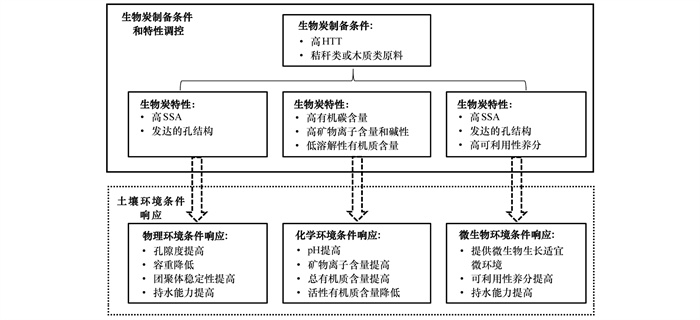2. 山东工业陶瓷研究设计院有限公司, 淄博 255000;
3. 青岛市环境卫生发展中心, 青岛 266071
2. Shandong Industrial Ceramic Research and Design Institute Co., Ltd., Zibo 255000, China;
3. Qingdao Environmental Health Development Center, Qingdao 266071, China
土壤氮、磷是植物正常生长所必需的营养元素.农业生产过程中施加的氮、磷等化肥中硝态氮和磷酸盐极易溶于水, 易随降水和灌溉等过程流失, 不仅导致养分利用率低, 而且还导致严重的水体富营养化面源污染[1, 2].据估计, 全球每年约有3.00×106~4.00×106 t P2O5排放到地下水中, 径流中农业生产系统年流失无机氮总量已超过1.70×106 t[3].在中国, 农业系统的净氮和净磷损失强度分别为0.78~23.7 kg·hm-2和0.03~0.31 kg·hm-2[4].中国长江入海溶解性无机磷年通量已从1972年的7.60×103 t增长至2007年的3.50×104 t; 同一时期入海溶解无机氮通量从2.00×105 t增长至1.30×106 t[5].中国非点源导致的氮、磷环境污染事件占比分别达81%和93%[6].综上, 农业生产过程中施肥所导致的氮、磷面源污染现已成为全球性的环境问题.因此, 提高农业土壤的氮和磷固持能力及其利用效率, 减少它们的淋失是当前研究的热点问题.
以生物质为原料, 在无氧(或限氧)条件高温热解制备的生物炭, 因其独特的理化特性和良好的吸附性能, 被广泛应用于土壤改良和污染修复等领域[7~10].有研究表明, 生物炭能够通过介导土壤物理条件(如持水能力、土壤颗粒团聚特性等)[9, 11]、土壤化学特性(如离子交换量、pH和物质/元素组分等)[9, 11, 12]和土壤微生物群落结构[13]等方面的变化, 进而对氮、磷在土壤中的迁移和循环过程产生影响.前期不同独立实验研究中, 由于所选择的受试土壤和生物炭类型、生物炭添加率等实验条件的差异, 导致现有的关于生物炭对土壤氮和磷淋失/固持等影响的结果之间存在很大的差异, 如对土壤硝态氮和磷酸盐淋失的影响既有正向的[14, 15]和负向的[16, 17], 也有无影响的[18].因此, 利用文献整合分析方法系统研究生物炭对土壤硝态氮和磷酸盐淋溶损失(或保持能力)的影响, 并阐明主要影响因素(生物炭和土壤特性、实验条件等)的作用规律和机制, 对于更好地指导生物炭的实践应用十分必要.Borchard等[19]和Glaser等[20]利用荟萃分析(Meta-analysis, MA)方法分别研究了生物炭对土壤硝态氮淋失和土壤可利用性磷含量的影响.但在上述两项研究中, 受所报道文献数量的限制, 无论从所收集数据的规模, 还是所考察影响因素指标的全面性等方面都存在一定欠缺.因此, 随着相关研究的增长, 十分有必要进行MA的更新研究, 通过更大数据规模和更加全面的研究以提高相关MA研究结果的科学性和可靠性.
本研究利用MA方法, 针对以下3个方面开展了研究:①明确生物炭添加对土壤硝态氮淋失及磷酸盐固持的总体影响; ②进一步明确相关考察因素(包括生物炭和土壤特性、实验条件等)对总体结果的影响; ③探讨生物炭降低硝态氮淋失和提高磷酸盐固持的主要过程机制, 并提出适宜的生物炭制备条件和特性.
1 材料与方法 1.1 数据收集为研究生物炭添加到土壤中对硝态氮淋失、磷酸盐固持的影响, 分别从ScienceDirect、Springer、百度学术和中国知网等数据库以“生物炭(biochar or BC or charcoal)”、“土壤(soil)”、“硝态氮(nitrate)”、“磷酸盐(phosphate)”、“淋溶(leaching)”、“固持(retention)”和“阻截(interpretation)”等为关键词搜索经同行评审的文献.对检索到的文献按照以下标准进行筛选[21]:①研究为室内或田间实验性质; ②实验设计包括对照组(无生物炭添加)和处理组(生物炭添加), 且每组数据仅以有无生物炭添加为唯一变量; ③每个实验处理须有3个及以上重复.所收集的每条成对数据(对照组和处理组)中除了硝态氮和磷酸盐指标(其中的一个或者两个)外, 还包括其他土壤特性[质地、黏粒含量、pH、阳离子交换量(cation exchange capacity, CEC)、有机碳(soil organic carbon, SOC)、总氮(total nitrogen, TN)和有效磷含量]、生物炭特性[原料、热解温度(heating treatment temperature, HTT)、pH、CEC、灰分含量(ash content, AC)、比表面积(specific surface area, SSA)、总碳(total carbon, TC)和TN]和实验条件(生物炭添加率和是否配施化肥), 见表 1.土壤中氮的存在形态众多, 且在非生物和生物等过程作用下, 硝态氮能够被转化为气态氮(如N2、N2O和NH3), 用土壤中硝态氮含量的变化无法表征生物炭对土壤硝态氮固持的影响.而对于磷酸盐而言, 其在土壤中的存在相对比较稳定.因此, 本研究以硝态氮的淋失量(淋溶液中硝态氮的浓度)的变化来表征生物炭对土壤硝态氮固持的影响, 与对照处理相比, 生物炭处理淋失量越低, 表明生物炭越能提高土壤硝态氮的固持.而对于生物炭对磷酸盐固持的影响, 既可通过土壤中磷酸盐含量, 也可以通过淋溶液中磷酸盐浓度进行表征, 但需要将这两个指标进行统一.本研究将报道的淋溶液磷酸盐浓度变化换算为土壤磷酸盐含量变化, 认为生物炭降低(增加)磷酸盐淋失量等于生物炭增加(降低)土壤磷酸盐含量, 例如:生物炭降低磷酸盐淋失为20%, 则认为土壤磷酸盐含量增加20%, 即土壤的磷酸盐固持提高20%.经筛选和数据收集, 用于硝态氮的相关研究共有41篇文献, 收集149条成对实验数据, 符合磷酸盐的相关研究共有36篇文献, 收集180条成对实验数据.
|
|
表 1 土壤硝酸盐淋失和磷酸盐固持对生物炭响应的Meta-analysis中各考察因素分组及其标准1) Table 1 Groups and classified standard for each examined factor in the Meta-analysis of responses of soil nitrate leaching and phosphate retention to biochar application |
数据收集过程中, 对于部分以图形式展示的文献数据利用Plot Digitizer软件( www.plotdigitizer.sourceforge.net)进行数值数据提取.此外, 部分数据还存在不同文献中单位不同或缺失等情况, 对于不同情况按照以下方式进行统一和补充:①将pH(CaCl2)利用公式pH(H2O)=1.65+0.86×pH(CaCl2)转化为pH(H2O)[22]; ②若文献只报道了土壤有机质(soil organic matter, SOM), 通过SOC=SOM×0.58确定SOC含量, 其中0.58为Bemmelen经验指数[23]; ③若文献报道方差分析结果为标准误(SE), 标准差(SD)可用SD=SE(n为处理的重复数)确定[21, 24]; ④若文章中未报道SD, 可按照指标值的±10%确定[21]; ⑤若文献报道的生物炭添加率为t·hm-2, 可通过土壤容重(文章若未提及, 采用统一数值1.3 g·cm-3)和施用土壤深度(文章若未提及, 采用20 cm)转化为添加率(%).
1.2 数据分析本研究利用MA方法定量研究土壤硝态氮淋失和磷酸盐固持对生物炭添加的响应.为了进一步考察不同因素(土壤特性、生物炭特性和实验条件)对生物炭介导的变量响应的影响, 综合不同MA研究中的分类标准和方法[20~22], 将各考察因素分成不同的组, 具体分组及其标准见表 1.重采样测试在999次迭代中完成, 并采用罗森塔尔法(Rosenthal's method)检测发表偏倚和MA结果的稳健性[21].当统计数据显著时(Kendall's Tau或Spearman Rank-order的P值其中之一或两者均小于0.05), 则认为存在发表偏倚, 需进一步比较失安全系数N与5n+10(n为实验组数), 当失安全系数N值大于5n+10时, 认为发表偏倚不影响数据趋势; 反之, 当统计数据不显著时(Kendall's Tau与Spearman Rank-order的P值均大于0.05), 则认为不存在发表偏倚, 不影响数据趋势[22].用组间异质性指数(Qb)和P值检验组间异质性(表 2).若某一分组指标的Qb处于显著性水平上(P<0.05), 说明该指标不同组之间的结果存在显著性差异.根据检验结果(表 2), 虽然部分考察因素存在发表偏倚, 但都通过了失安全系数检验, 表明MA所得结果具有高的稳健性.
|
|
表 2 Meta-analysis中各分组的发表偏倚和组间异质性检验结果 Table 2 Statistical results of publication bias and heterogeneity for each group used in the Meta-analysis |
使用软件MetaWin 2.1中的随机-效应模型进行结果处理, 通过将实验结果标准化为效应量来对各实验结果进行综合分析, MA允许对不同实验变量的多个研究结果进行精确的统计比较.效应量是响应值(RR)的自然对数:

|
(1) |
式中, Xt为生物炭处理组均值, Xc为对照组均值.
土壤硝态氮淋失量和磷酸盐固持的变化率表示为:

|
(2) |
对每个变量组来说, ln(RR)=0表示无效应, ln(RR)>0表示为增强效应, ln(RR)<0表示为减弱效应.经对数转换的数据用于计算总体响应值及每个组的95%置信区间.若两组95%置信区间不存在重叠, 表明其间存在显著差异; 若置信区间不与零重叠, 表明生物炭添加组与对照组之间存在显著差异.
1.3 结果处理MA数据处理及结果图绘制综合运用Microsoft Excel 2010和OriginPro 2017软件完成.MA的结果通过森林图展示, 森林图给出每组数据的总体平均响应值及95%置信区间.
2 结果与分析 2.1 生物炭对土壤硝态氮淋滤的影响 2.1.1 生物炭特性对土壤硝态氮淋滤响应的影响土壤硝态氮淋失对生物炭添加的总体响应及其在不同因素分组中的变化等结果见图 1.与对照相比, 生物炭添加可显著减少硝态氮淋失量为37.1%(全组均值, 不考虑任何影响因素), 表明生物炭对硝态氮的淋失具有积极的抑制效应.然而, 不同生物炭或土壤特性组中的响应值表现出明显差异, 说明各考察因素对硝态氮淋失响应具有不同的影响.如图 1(a)所示, 硝态氮淋失响应值在不同的生物炭原料、pH、CEC、AC、SSA、TC和TN等的各自分组之间的变化较小, 且它们的组间异质性检验结果P值均高于0.05(表 2), 意味着上述生物炭特性指标的变化不会对硝态氮淋失响应产生显著性影响.C/N≤50组与对照相比, 硝态氮淋失量可显著减少68.2% [图 1(a)], 表明低C/N的生物炭更加有利于减少硝态氮的淋失.相反, 在HTT<400℃的组中, 与对照相比硝态氮淋失量仅显著减少14.2%, 说明低HTT制备的生物炭表现出较弱的抑制硝态氮淋失损失的潜力.在所有生物炭组中, C/N≤50组中硝态氮淋失损失减少的潜力最大(-68.2%), 其次是HTT为400~600℃组(-43.6%).此外, 从不同AC组间的结果来看, 当生物炭AC≥10%时, 灰分含量越高, 硝态氮淋失的减少潜力越大.

|
(a)生物炭特性组, (b)土壤特性组, (c)实验条件组(各因素分组及其标准的详细信息见表 1); 括号内的数值为该分组的样本数量 图 1 土壤硝态氮淋失对生物炭添加响应结果 Fig. 1 Results of the response of soil nitrate leaching to biochar application |
土壤硝态氮淋失对生物炭添加的响应受土壤特性的影响见图 1(b), 结合表 2中组间异质性检验的结果显示, 所有土壤特性指标对硝态氮淋失响应均无显著性影响.从不同土壤质地与黏粒含量两指标各自组间的硝态氮淋失响应值的变化规律来看, 随着土壤黏粒含量升高, 生物炭减少硝态氮淋失的潜力下降, 如硝态氮淋失减少量从砂土组的41.1%下降到黏粒组的24.6%、从黏粒含量≤15%组的42.2%下降到黏粒含量≥15%组的27.6%.由此推断土壤黏粒含量越高, 越不利于生物炭减少硝态氮的淋失.而在土壤CEC>20 cmol·kg-1组中, 硝态氮淋失减少潜力为-23.7%, 远低于总体平均响应值(-37.1%), 说明土壤CEC较高时, 生物炭添加更倾向于促进硝态氮的淋失.土壤CEC表现出与生物炭CEC较为一致的对硝态氮淋失的影响规律, 说明较高的CEC值可能是促进硝态氮淋失的重要因子.所有土壤指标组, 在土壤pH为7~8(-42.6%)和SOC<10 g·kg-1(-39.7%)的组中, 生物炭表现出最高的减少硝态氮淋失的作用潜力.
2.1.3 实验条件对土壤硝态氮淋滤响应的影响土壤硝态氮淋失对生物炭添加的响应受实验条件的影响见图 1(c).与不配施化肥相比, 配施化肥的条件下生物炭减少硝态氮淋失的作用效果更明显.低生物炭添加率(≤1%)的组中, 生物炭降低硝态氮淋失的潜力显著低于其他两个高添加两组, 这表明生物炭对硝态氮淋失的作用潜力受一定规模效应的影响.
2.2 生物炭添加对土壤磷酸盐固持的影响 2.2.1 生物炭特性对土壤磷酸盐固持响应的影响土壤磷酸盐固持对生物炭添加的总体响应及其在不同因素分组中的变化见图 2.与对照相比, 生物炭添加可显著提高磷酸盐固持量为20.8%(全组均值, 不考虑任何影响因素), 表明生物炭对磷酸盐的固持具有积极的提高潜力.但对于单个生物炭指标而言, 不同考察指标对生物炭介导的磷酸盐固持响应的影响具有明显的差异.从具体结果来看, 磷酸盐固持最大的正响应值出现在SSA>100 m2·g-1(62.8%)和HTT≥600℃(61.7%)组中; 而在生物炭pH≤7组中, 生物炭的添加显著降低了磷酸盐固持, 响应值为-29.7%.从各指标的不同组之间的磷酸盐固持响应值变化规律来看, 随着HTT、pH、AC或SSA升高, 生物炭提高磷酸盐固持的潜力升高.这些规律说明生物炭的HTT越高、AC和SSA越大以及pH呈较强碱性时, 越有利于提高磷酸盐固持.相反, 随着生物炭CEC和TC升高, 生物炭越不利于磷酸盐固持的提高.

|
(a)生物炭特性组, (b)土壤特性组, (c)实验条件组(各因素分组及其标准的详细信息见表 1); 括号内的数值为该分组的样本数量 图 2 土壤磷酸盐固持对生物炭添加结果 Fig. 2 Results of the response of soil phosphate retention to biochar application |
根据图 2(b)和表 2中组间异质性检验的结果显示:除SOC外(Qb=11.350, P=0.018), 其他所有土壤特性指标对磷酸盐固持响应均无显著性影响.值得注意的是, 虽然在土壤CEC为10~20 cmol·kg-1和SOC≥20 g·kg-1的组中观测到负响应值, 但是与对照相比没有显著性差异.上述结果表明, 土壤特性对生物炭介导的磷酸盐固持的变化影响很小.总体上来看, 生物炭添加到高黏粒、高pH、高CEC或低SOC的土壤中, 更加有利于其提高磷酸盐固持.此外, 磷酸盐固持响应在不同生物炭添加率下无显著性差异[图 2(c)], 表明生物炭添加规模效应对磷酸盐固持的影响很小.
3 讨论 3.1 生物炭对土壤硝态氮淋失影响的潜在机制Borchard等[19]的MA研究结果显示:生物炭添加能够减少硝态氮淋失量为26%~32%.该结论与本文所得到的37.1%较为一致.同时, 在笔者先前的研究中发现, 生物炭添加对土壤硝态氮含量无显著性影响[21].由此可推断, 生物炭减少硝态氮淋失可能由两方面的机制同时发生作用(图 3):一是生物炭通过物理化学吸附直接固定硝态氮; 二是通过促进硝态氮向其他氮形态的转化或抑制其他氮形态向硝态氮转化, 减少土壤中可用于淋失的硝态氮含量.

|
虚线框内为土壤/微生物对特定生物炭添加的潜在响应, 虚线箭头为生物炭直接的或间接的对硝态氮吸附/转化的潜在作用 图 3 生物炭降低土壤硝态氮淋失的潜在机制和适宜生物炭制备和特性条件 Fig. 3 Potential mechanisms of reducing soil nitrate leaching by biochar and the suitable production conditions and properties of biochar |
有研究表明, 生物炭通常含有较高的负表面电荷(如负电荷的官能团—COO-、—COH、—OH和CO32-等)[25]及较低的等电点[26], 导致其对硝态氮等阴离子具有较强的排斥力, 因而具有较差的吸附性能[22].因此, 高CEC的生物炭将不利于硝态氮的吸附固持[图 1(a)].然而, 生物炭灰分中的金属氧化物, 如MgO和CaO等物质具有较高的等电点, 可通过静电吸引的方式增加对硝态氮的吸附, 因而较高AC的生物炭有利于硝态氮的固持[图 1(a)].生物炭的物理结构特性(如SSA、孔径分布和孔体积等)是影响生物炭对硝态氮吸附性能的关键因素[27], 且两者之间通常存在正相关的关系[22].然而, 本文MA的结果显示, 最佳的减少硝态氮淋失潜力出现在中等SSA(50~100 m2·g-1)生物炭组, 且不同SSA生物炭组之间差异不显著, 表明生物炭的SSA对其减少硝态氮淋失潜力的贡献有限.制备原料和HTT是影响生物炭特性的两个重要因素[28~30].一般来说, 污泥等有机废弃物制备的生物炭营养物质和AC较高, 但其TC很低, 所制备的生物炭SSA较小和孔隙不发达[31, 32]; 同时, 秸秆类生物炭与木质类生物炭相比, 其AC和pH值较高, 因而对硝态氮具有更强的吸附能力[33].由此推断, 秸秆类生物炭具有更大的减少硝态氮淋失的潜力, 这一点在本次MA中得到了进一步证实[图 1(a)].从HTT方面来看, 随着HTT的升高, 在低HTT条件下生成的酸性含氧官能团(如—COO-、—COH、—OH和CO32-)[25]逐渐分解并转化为中性或碱性的融合芳香基团(包括色胺、酮和吡喃), 导致CEC降低[34, 35], 且生物炭的AC、pH和SSA逐渐升高[28].因此, 相对于低HTT, 高HTT制备的生物炭有利于阴离子(如硝态氮)的吸附[36].然而, 本文的MA结果发现, 相对于高HTT(≥600)组, 中等HTT(400~600℃)生物炭组表现出更大的减少硝态氮淋失的潜力, 说明HTT过高反而会削弱生物炭减少硝态氮淋失的潜力.这可能因为当温度升高超过某一阈值时, 生物炭的结构就会发生变化, 而导致SSA减少.例如, Chun等[37]报道了当HTT从600℃升高到700℃时, 小麦秸秆生物炭的SSA从438 m2·g-1下降到363 m2·g-1.此外, 相关研究还提出生物炭对硝态氮的吸附可能通过硝态氮与生物炭表面之间非常规的氢键结合[22].然而, 本研究的MA中因可收集数据的限制, 未涉及该方面内容, 在未来研究中应值得关注.
生物炭添加通过改变土壤pH、活性有机碳源(如溶解有机碳)、氧环境和含水率等特性, 改变土壤氮转化相关微生物的活性和群落结构[38, 39]. Wang等[38]发现花生壳生物炭能够显著提高土壤pH和SOM含量, 而降低容重, 导致显著降低氨氧化细菌的丰度, 进而抑制土壤硝化过程.在另外一项MA研究中发现:生物炭添加能够显著增加反硝化功能基因丰度(如narG、nirK和nirS), 并且进一步揭示这一增加结果与生物炭对土壤通透性和容重的改善密切相关[13].
此外, 生物炭中活性有机碳源可诱导微生物固定氮或通过在老化生物炭上的有机碳层捕获硝态氮分子, 也可提供维持微生物代谢所需的能量和还原硝酸根所需的电子, 促进反硝化作用[40, 41].综上, 生物炭通过对土壤上述特性的改变, 抑制或促进硝化或反硝化过程, 降低土壤中硝态氮的总量, 也就意味着土壤中可用于发生淋失的硝态氮的量降低.然而, 生物炭对土壤特性的影响取决于其初始特性, 而原料和HTT是影响生物炭初始特性的关键因素.通常来讲, 相对于低HTT(<500℃)或其他有机废弃物原料(如污水污泥和动物粪便), 高HTT(如>500℃)或木质纤维素含量高的原料(如木质和秸秆类原料)条件下制备的生物炭具有更好的物理结构、更高的pH和有机碳含量[28].这一类生物炭对土壤反硝化过程具有更大的促进潜力.这与本研究MA得到的结论较为一致:中等或高HTT和木质或秸秆类原料的生物炭组表现出更大的减少硝态氮淋失的潜力[图 1(a)].
3.2 生物炭对土壤磷酸盐固持影响的过程和机制磷酸盐在土壤中的动态变化过程主要受以下3个方面控制(图 4), 包括:①土壤化学环境, 如pH和阴离子交换量(anion exchange capacity, AEC)等条件调控的磷酸盐吸附/解吸、沉淀/溶解平衡和有机-矿物复合物等[18, 42, 43]; ②土壤物理环境, 如容重和孔隙度等[14]; ③土壤微生物环境等[44, 45].

|
虚线框内为土壤环境条件对特定生物炭添加的潜在响应 图 4 生物炭提高土壤磷酸盐固持的潜在机制和适宜生物炭特性 Fig. 4 Potential mechanisms of enhancing soil phosphate retention by biochar and the suitable biochar properties |
生物炭添加能够引起土壤化学环境(如pH、离子交换和SOM含量等)的显著变化, 进而引起固磷矿物的沉淀/溶解等平衡发生改变[14, 46, 47].土壤pH可调节固磷矿物在土壤中的吸附特征和各种含磷矿物的溶解度.在酸性土壤中, 磷主要被Fe和Al固持, 而在碱性土壤中, 则主要被Ca和Mg固持, 且环境pH>7时, 更有利于Ca/Mg磷酸盐沉淀的形成[42].因此生物炭具备的“石灰效应(liming effect)”对增强土壤的磷酸盐固持具有积极作用.本研究的MA结果也证实高pH生物炭或生物炭在碱性土壤中应用, 表现出更好的磷酸盐固持提高效果[图 2(a)和2(b)].土壤的离子交换环境能直接影响磷酸根的吸附/解吸过程.当生物炭表面有大量氧鎓基团、吡啶基团和质子化芳香结构时, 其具有较高的AEC, 有利于增加对阴离子(如磷酸根)的吸附[48, 49].此外, 生物炭灰分中含有的Fe、Al、Ca和Mg等离子可通过沉淀或阳离子桥来捕获磷酸根[49~51].因此, 高AC或低CEC的生物炭更加有利于磷酸盐的吸附固持, 相反则不利于磷酸盐的吸附固持[图 2(a)].SOM特征也是影响磷动态变化的重要因素.最新研究发现生物炭衍生的溶解有机质(BDOM)可能参与(生物)地球化学过程:相比自然溶解性有机质, BDOM拥有更多的活性官能团(如—OH和—COOH), 这可能导致土壤矿物上已吸附的磷与含氧阴离子对吸附位点的竞争[52], 该竞争可随土壤pH值的变化而变化[53]; BDOM也可吸附金属离子, 改变土壤磷的吸附/解吸和沉淀/溶解过程, 进一步与磷形成有机络合物组分[52, 53]; 另外, 在富含Fe/Al氧化物的酸性土壤中, pH值的小幅增加可导致磷与土壤矿物质的相互作用大幅度减弱[46, 54], BDOM可作为电子穿梭体, 在Fe(Ⅲ)矿物和微生物之间传递电子, 推动Fe(Ⅲ)还原, 从而释放矿物伴生的磷[55, 56].低HTT制备的生物炭, 通常含有较高的BDOM含量, 那么其是不是导致该类生物炭存在潜在的增加土壤磷酸盐淋失风险的原因[如图 2(a)中的低和中HTT生物炭组]?这一点值得在后期的研究中关注.
生物炭添加的土壤物理环境对磷固持的影响主要体现在对磷的存储和其流动性上.研究表明, 生物炭具有较大的SSA和大量的微孔, 可通过孔隙填充机制增加对流动磷的吸附[57].因此生物炭SSA越大, 对土壤磷酸盐固持提高潜力越大[图 2(a)].添加生物炭后, 土壤孔隙度增加、容重降低和团聚体稳定性提高等有益效应也会间接提高土壤保水能力[14, 58, 59], 土壤持水能力的增加将减少营养物质的流失[60], 同时也可通过促进植物对磷的吸收来减少磷的损失[54].此外, 土壤水分的入渗速率、渗透性和排水途径也会受生物炭的添加而有所改变, 从而降低磷的淋失风险[61, 62].
生物炭添加可对土壤微生物磷循环产生复杂的影响[63].如生物炭的物理特征(如发达的孔隙结构和大SSA)可改变土壤微气候和水分环境, 从而有利于微生物的生长繁殖, 使得微生物在干燥的气候条件下也能生存[64, 65]; 土壤pH值的变化可诱导酶活性及微生物种群(如溶磷菌溶解无机磷)的变化[66, 67]; 生物炭提供的营养物质及躲避捕食者的庇护场所, 有利于真菌菌根的生长和溶磷菌的存活, 从而使得微生物的生物量增加, 这反过来可提高磷的可用性或在土壤中的固持, 进一步影响内源磷在土壤中的溶解性[68].除上述有利于微生物磷循环的优点外, 高HTT制备的生物炭也容易产生较多损害微生物生长繁殖的物质[57, 69], 在今后的研究中有必要深入探讨毒性物质对土壤微生物磷循环的影响.
4 结论(1) 总体上, 生物炭能够显著减少硝态氮淋失37.1%, 显著提高磷酸盐固持20.8%.
(2) 生物炭C/N、HTT和添加率对硝态氮淋失响应具有显著影响, 而其他考察因素则无显著性影响; 生物炭SSA、HTT和SOC含量对磷酸盐固持响应具有显著影响, 其他因素则无显著性影响.
(3) 秸秆和木质类原料、中高HTT(400~600℃)条件下制备的生物炭适宜于减少土壤硝态氮的淋失; 秸秆和木质类原料、高HTT(>600℃)条件下制备的生物炭适宜于提高土壤磷酸盐的固持.
| [1] | Carpenter S R, Caraco N F, Correll D L, et al. Nonpoint pollution of surface waters with phosphorus and nitrogen[J]. Ecological Applications, 1998, 8(3): 559-568. DOI:10.1890/1051-0761(1998)008[0559:NPOSWW]2.0.CO;2 |
| [2] | Camargo J A, Alonso Á. Ecological and toxicological effects of inorganic nitrogen pollution in aquatic ecosystems: a global assessment[J]. Environment International, 2006, 32(6): 831-849. DOI:10.1016/j.envint.2006.05.002 |
| [3] | Zhang D B, Yao P W, Zhao N, et al. Contribution of green manure legumes to nitrogen dynamics in traditional winter wheat cropping system in the Loess Plateau of China[J]. European Journal of Agronomy, 2016, 72: 47-55. DOI:10.1016/j.eja.2015.09.012 |
| [4] | Huang J, Xu C C, Ridoutt B G, et al. Nitrogen and phosphorus losses and eutrophication potential associated with fertilizer application to cropland in China[J]. Journal of Cleaner Production, 2017, 159: 171-179. DOI:10.1016/j.jclepro.2017.05.008 |
| [5] | 徐皓. 长江口溶解氮磷迁移通量估算及其对河口生态的影响[A]. 见: 2015年浙江省地理学会学术年会会议论文摘要集[C]. 宁波: 浙江省地理学会, 2015. |
| [6] | Ongley E D, Zhang X L, Yu T. Current status of agricultural and rural non-point source Pollution assessment in China[J]. Environmental Pollution, 2010, 158(5): 1159-1168. DOI:10.1016/j.envpol.2009.10.047 |
| [7] | Wu P, Wang Z Y, Wang H L, et al. Visualizing the emerging trends of biochar research and applications in 2019:a scientometric analysis and review[J]. Biochar, 2020, 2(2): 135-150. DOI:10.1007/s42773-020-00055-1 |
| [8] | Lu L, Yu W T, Wang Y F, et al. Application of biochar-based materials in environmental remediation: from multi-level structures to specific devices[J]. Biochar, 2020, 2(1): 1-31. DOI:10.1007/s42773-020-00041-7 |
| [9] | Hossain M Z, Bahar M M, Sarkar B, et al. Biochar and its importance on nutrient dynamics in soil and plant[J]. Biochar, 2020, 2(4): 379-420. DOI:10.1007/s42773-020-00065-z |
| [10] | Wang J L, Wang S Z. Preparation, modification and environmental application of biochar: a review[J]. Journal of Cleaner Production, 2019, 227: 1002-1022. DOI:10.1016/j.jclepro.2019.04.282 |
| [11] | Purakayastha T J, Bera T, Bhaduri D, et al. A review on biochar modulated soil condition improvements and nutrient dynamics concerning crop yields: pathways to climate change mitigation and global food security[J]. Chemosphere, 2019, 227: 345-365. DOI:10.1016/j.chemosphere.2019.03.170 |
| [12] | Gul S, Whalen J K, Thomas B W, et al. Physico-chemical properties and microbial responses in biochar-amended soils: mechanisms and future directions[J]. Agriculture, Ecosystems & Environment, 2015, 206: 46-59. |
| [13] | Xiao Z G, Rasmann S, Yue L, et al. The effect of biochar amendment on N-cycling genes in soils: a meta-analysis[J]. Science of the Total Environment, 2019, 696. DOI:10.1016/j.scitotenv.2019.133984 |
| [14] | Sachdeva V, Hussain N, Husk B R, et al. Biochar-induced soil stability influences phosphorus retention in a temperate agricultural soil[J]. Geoderma, 2019, 351: 71-75. DOI:10.1016/j.geoderma.2019.05.029 |
| [15] | Matin N H, Jalali M, Antoniadis V, et al. Almond and walnut shell-derived biochars affect sorption-desorption, fractionation, and release of phosphorus in two different soils[J]. Chemosphere, 2020, 241. DOI:10.1016/j.chemosphere.2019.124888 |
| [16] | Guo Y J, Tang H, Li G D, et al. Effects of cow dung biochar amendment on adsorption and leaching of nutrient from an acid yellow soil irrigated with biogas slurry[J]. Water, Air, & Soil Pollution, 2014, 225(1). DOI:10.1007/s11270-013-1820-x |
| [17] | Laird D, Fleming P, Wang B Q, et al. Biochar impact on nutrient leaching from a Midwestern agricultural soil[J]. Geoderma, 2010, 158(3-4): 436-442. DOI:10.1016/j.geoderma.2010.05.012 |
| [18] | Soinne H, Hovi J, Tammeorg P, et al. Effect of biochar on phosphorus sorption and clay soil aggregate stability[J]. Geoderma, 2014, 219-220: 162-167. DOI:10.1016/j.geoderma.2013.12.022 |
| [19] | Borchard N, Schirrmann M, Cayuela M L, et al. Biochar, soil and land-use interactions that reduce nitrate leaching and N2 O emissions: a meta-analysis[J]. Science of the Total Environment, 2019, 651: 2354-2364. DOI:10.1016/j.scitotenv.2018.10.060 |
| [20] | Glaser B, Lehr V I. Biochar effects on phosphorus availability in agricultural soils: a meta-analysis[J]. Scientific Reports, 2019, 9(1). DOI:10.1038/s41598-019-45693-z |
| [21] | Dai Y H, Zheng H, Jiang Z X, et al. Combined effects of biochar properties and soil conditions on plant growth: a meta-analysis[J]. Science of the Total Environment, 2020, 713. DOI:10.1016/j.scitotenv.2020.136635 |
| [22] | Nguyen T T N, Xu C Y, Tahmasbian I, et al. Effects of biochar on soil available inorganic nitrogen: A review and meta-analysis[J]. Geoderma, 2017, 288: 79-96. DOI:10.1016/j.geoderma.2016.11.004 |
| [23] | Liu S W, Zhang Y J, Zong Y J, et al. Response of soil carbon dioxide fluxes, soil organic carbon and microbial biomass carbon to biochar amendment: a meta-analysis[J]. Global Change Biology Bioenergy, 2016, 8(2): 392-406. DOI:10.1111/gcbb.12265 |
| [24] | Luo Y Q, Hui D F, Zhang D Q. Elevated CO2 stimulates net accumulations of carbon and nitrogen in land ecosystems: a meta-analysis[J]. Ecology, 2006, 87(1): 53-63. DOI:10.1890/04-1724 |
| [25] | Yuan J H, Xu R K, Zhang H. The forms of alkalis in the biochar produced from crop residues at different temperatures[J]. Bioresource Technology, 2011, 102(3): 3488-3497. DOI:10.1016/j.biortech.2010.11.018 |
| [26] | Xu X, Gao B Y, Yue Q Y, et al. Preparation of agricultural by-product based anion exchanger and its utilization for nitrate and phosphate removal[J]. Bioresource Technology, 2010, 101(22): 8558-8564. DOI:10.1016/j.biortech.2010.06.060 |
| [27] | Liu Y X, Lonappan L, Brar S K, et al. Impact of biochar amendment in agricultural soils on the sorption, desorption, and degradation of pesticides: a review[J]. Science of the Total Environment, 2018, 645: 60-70. DOI:10.1016/j.scitotenv.2018.07.099 |
| [28] | Ippolito J A, Cui L Q, Kammann C, et al. Feedstock choice, pyrolysis temperature and type influence biochar characteristics: a comprehensive meta-data analysis review[J]. Biochar, 2020, 2(4): 421-438. DOI:10.1007/s42773-020-00067-x |
| [29] | Hassan M, Liu Y J, Naidu R, et al. Influences of feedstock sources and pyrolysis temperature on the properties of biochar and functionality as adsorbents: a meta-analysis[J]. Science of the Total Environment, 2020, 744. DOI:10.1016/j.scitotenv.2020.140714 |
| [30] | Ghodake G S, Shinde S K, Kadam A A, et al. Review on biomass feedstocks, pyrolysis mechanism and physicochemical properties of biochar: state-of-the-art framework to speed up vision of circular bioeconomy[J]. Journal of Cleaner Production, 2021, 297. DOI:10.1016/j.jclepro.2021.126645 |
| [31] |
刘凯传, 刘佳欢, 孙甲玉, 等. 污泥-秸秆混合基生物炭对土壤性质和植物生长的影响[J]. 山东农业大学学报(自然科学版), 2018, 49(6): 1015-1019. Liu K C, Liu J H, Sun J Y, et al. Effect of sludge-straw mixture biochar on soil properties and plant growth[J]. Journal of Shandong Agricultural University (Natural Science Edition), 2018, 49(6): 1015-1019. DOI:10.3969/j.issn.1000-2324.2018.06.022 |
| [32] | Yin X W, Xi M, Li Y, et al. Improvements in physicochemical and nutrient properties of sewage sludge biochar by the co-pyrolysis with organic additives[J]. Science of the Total Environment, 2021, 779. DOI:10.1016/j.scitotenv.2021.146565 |
| [33] | Vushe A, Amutenya M. Investigating nitrate retention capacity, elementary and mineral composition of Kalahari sandy soils at Mashare farm in Namibia, Okavango river basin[J]. Scientific African, 2019, 6. DOI:10.1016/j.sciaf.2019.e00193 |
| [34] | Gai X P, Wang H Y, Liu J, et al. Effects of feedstock and pyrolysis temperature on biochar adsorption of ammonium and nitrate[J]. PLoS One, 2014, 9(12). DOI:10.1371/journal.pone.0113888 |
| [35] | Gaskin J, Steiner C, Harris K, et al. Effect of low-temperature pyrolysis conditions on biochar for agricultural use[J]. Transactions of the ASABE, 2008, 51(6): 2061-2069. DOI:10.13031/2013.25409 |
| [36] | Amonette J E, Joseph S. Characteristics of biochar: microchemical properties[A]. In: Lehmann J, Joseph S (Eds. ). Biochar for Environmental Management: Science and Technology[M]. London: Routledge, 2009. |
| [37] | Chun Y, Sheng G Y, Chiou C T, et al. Compositions and sorptive properties of crop residue-derived chars[J]. Environmental Science & Technology, 2004, 38(17): 4649-4655. |
| [38] | Wang Z Y, Chen L, Sun F L, et al. Effects of adding biochar on the properties and nitrogen bioavailability of an acidic soil[J]. European Journal of Soil Science, 2017, 68(4): 559-572. DOI:10.1111/ejss.12436 |
| [39] | Dai Z M, Xiong X Q, Zhu H, et al. Association of biochar properties with changes in soil bacterial, fungal and fauna communities and nutrient cycling processes[J]. Biochar, 2021, 3(3): 239-254. DOI:10.1007/s42773-021-00099-x |
| [40] | Ahn Y H. Sustainable nitrogen elimination biotechnologies: a review[J]. Process Biochemistry, 2006, 41(8): 1709-1721. DOI:10.1016/j.procbio.2006.03.033 |
| [41] | Barnard R, Leadley P W, Hungate B A. Global change, nitrification, and denitrification: a review[J]. Global Biogeochemical Cycles, 2005, 19(1). DOI:10.1029/2004gb002282 |
| [42] | Bornø M L, Müller-Stöver D S, Liu F L. Contrasting effects of biochar on phosphorus dynamics and bioavailability in different soil types[J]. Science of the Total Environment, 2018, 627: 963-974. DOI:10.1016/j.scitotenv.2018.01.283 |
| [43] | Gao S, DeLuca T H. Influence of biochar on soil nutrient transformations, nutrient leaching, and crop yield[J]. Advances in Plants & Agriculture Research, 2016, 4(5): 348-362. |
| [44] | de Oliveira Mendes G, Zafra D L, Vassilev N, et al. Biochar enhances Aspergillus niger rock phosphate solubilization by increasing organic acid production and alleviating fluoride toxicity[J]. Applied and Environmental Microbiology, 2014, 80(10): 3081-3085. DOI:10.1128/AEM.00241-14 |
| [45] | Warnock D D, Lehmann J, Kuyper T W, et al. Mycorrhizal responses to biochar in soil-concepts and mechanisms[J]. Plant and Soil, 2007, 300(1-2): 9-20. DOI:10.1007/s11104-007-9391-5 |
| [46] | Eduah J O, Nartey E K, Abekoe M K, et al. Phosphorus retention and availability in three contrasting soils amended with rice husk and corn cob biochar at varying pyrolysis temperatures[J]. Geoderma, 2019, 341: 10-17. DOI:10.1016/j.geoderma.2019.01.016 |
| [47] | Anderson C R, Condron L M, Clough T J, et al. Biochar induced soil microbial community change: implications for biogeochemical cycling of carbon, nitrogen and phosphorus[J]. Pedobiologia, 2011, 54(5-6): 309-320. DOI:10.1016/j.pedobi.2011.07.005 |
| [48] | Lawrinenko M, Laird D A. Anion exchange capacity of biochar[J]. Green Chemistry, 2015, 17(9): 4628-4636. DOI:10.1039/C5GC00828J |
| [49] | Chintala R, Schumacher T E, McDonald L M, et al. Phosphorus sorption and availability from biochars and soil/biochar mixtures[J]. Clean-Soil Air Water, 2014, 42(5): 626-634. DOI:10.1002/clen.201300089 |
| [50] | Shepherd J G, Joseph S, Sohi S P, et al. Biochar and enhanced phosphate capture: mapping mechanisms to functional properties[J]. Chemosphere, 2017, 179: 57-74. DOI:10.1016/j.chemosphere.2017.02.123 |
| [51] | Qian T T, Yang Q, Jun D C F, et al. Transformation of phosphorus in sewage sludge biochar mediated by a phosphate-solubilizing microorganism[J]. Chemical Engineering Journal, 2019, 359: 1573-1580. DOI:10.1016/j.cej.2018.11.015 |
| [52] | Xu G, Sun J N, Shao H B, et al. Biochar had effects on phosphorus sorption and desorption in three soils with differing acidity[J]. Ecological Engineering, 2014, 62: 54-60. DOI:10.1016/j.ecoleng.2013.10.027 |
| [53] | Schneider F, Haderlein S B. Potential effects of biochar on the availability of phosphorus-mechanistic insights[J]. Geoderma, 2016, 277: 83-90. DOI:10.1016/j.geoderma.2016.05.007 |
| [54] | DeLuca T H, Gundale M J, Mackenzie M D, et al. Biochar effects on soil nutrient transformations[A]. In: Lehmann J, Joseph S (Eds. ). Biochar for Environmental Management: Science, Technology and Implementation (2nd ed. )[M]. London: Routledge, 2015. |
| [55] | Liptzin D, Silver W L. Effects of carbon additions on iron reduction and phosphorus availability in a humid tropical forest soil[J]. Soil Biology and Biochemistry, 2009, 41(8): 1696-1702. DOI:10.1016/j.soilbio.2009.05.013 |
| [56] | Wu C, An W H, Liu Z Y, et al. The effects of biochar as the electron shuttle on the ferrihydrite reduction and related arsenic (As) fate[J]. Journal of Hazardous Materials, 2020, 390. DOI:10.1016/j.jhazmat.2019.121391 |
| [57] | Shaaban M, van Zwieten L, Bashir S, et al. A concise review of biochar application to agricultural soils to improve soil conditions and fight pollution[J]. Journal of Environmental Management, 2018, 228: 429-440. |
| [58] | Baiamonte G, de Pasquale C, Marsala V, et al. Structure alteration of a sandy-clay soil by biochar amendments[J]. Journal of Soils and Sediments, 2015, 15(4): 816-824. DOI:10.1007/s11368-014-0960-y |
| [59] | Xu G, Zhang Y, Sun J N, et al. Negative interactive effects between biochar and phosphorus fertilization on phosphorus availability and plant yield in saline sodic soil[J]. Science of the Total Environment, 2016, 568: 910-915. DOI:10.1016/j.scitotenv.2016.06.079 |
| [60] | Olmo M, Villar R, Salazar P, et al. Changes in soil nutrient availability explain biochar's impact on wheat root development[J]. Plant and Soil, 2016, 399(1-2): 333-343. DOI:10.1007/s11104-015-2700-5 |
| [61] | Lal R. Restoring soil quality to mitigate soil degradation[J]. Sustainability, 2015, 7(5). DOI:10.3390/su7055875 |
| [62] | Batista E M C C, Shultz J, Matos T T S, et al. Effect of surface and porosity of biochar on water holding capacity aiming indirectly at preservation of the Amazon biome[J]. Scientific Reports, 2018, 8. DOI:10.1038/s41598-018-28794-z |
| [63] | Gao S, DeLuca T H, Cleveland C C. Biochar additions alter phosphorus and nitrogen availability in agricultural ecosystems: a meta-analysis[J]. Science of the Total Environment, 2019, 654: 463-472. DOI:10.1016/j.scitotenv.2018.11.124 |
| [64] | Ameloot N, Graber E R, Verheijen F G A, et al. Interactions between biochar stability and soil organisms: review and research needs[J]. European Journal of Soil Science, 2013, 64(4): 379-390. DOI:10.1111/ejss.12064 |
| [65] | Zheng B X, Ding K, Yang X R, et al. Straw biochar increases the abundance of inorganic phosphate solubilizing bacterial community for better rape (Brassica napus) growth and phosphate uptake[J]. Science of the Total Environment, 2019, 647: 1113-1120. DOI:10.1016/j.scitotenv.2018.07.454 |
| [66] | Gao S, Hoffman-Krull K, DeLuca T H. Soil biochemical properties and crop productivity following application of locally produced biochar at organic farms on Waldron Island, WA[J]. Biogeochemistry, 2017, 136(1): 31-46. DOI:10.1007/s10533-017-0379-9 |
| [67] | Gul S, Whalen J K. Biochemical cycling of nitrogen and phosphorus in biochar amended soils[J]. Soil Biology and Biochemistry, 2016, 103: 1-15. DOI:10.1016/j.soilbio.2016.08.001 |
| [68] | Rafique M, Ortas I, Rizwan M, et al. Residual effects of biochar and phosphorus on growth and nutrient accumulation by maize (Zea mays L.) amended with microbes in texturally different soils[J]. Chemosphere, 2020, 238. DOI:10.1016/j.chemosphere.2019.124710 |
| [69] | Domene X, Mattana S, Hanley K, et al. Medium-term effects of corn biochar addition on soil biota activities and functions in a temperate soil cropped to corn[J]. Soil Biology and Biochemistry, 2014, 72: 152-162. DOI:10.1016/j.soilbio.2014.01.035 |
 2022, Vol. 43
2022, Vol. 43

